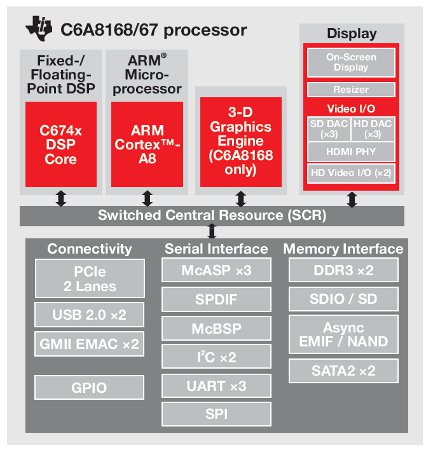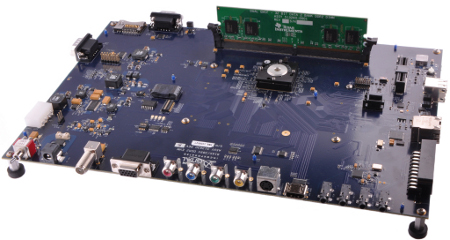Machine-vision SoCs mix 1.5GHz Cortex-A8 and DSP cores
Oct 19, 2010 — by Eric Brown — from the LinuxDevices Archive — 6 viewsTexas Instruments (TI) announced the first two members of a Linux- and Android-ready “Integra” family of system-on-chips (SoC) aimed at machine-vision applications. The C6A8167 Integra and 3D-accelerated C6A8168 Integra combine a 1.5GHz ARM Cortex-A8 core with a 1.5GHz digital signal processor (DSP), and support dual HD displays as well as peripherals including PCIe, gigabit Ethernet, USB 2.0, and HDMI.
The C6A816x Integra SoCs are designed for applications such as machine vision, test and measurement and tracking and control, says TI. As with TI's other ARM/DSP combo SoCs, the ARM core is available for graphical user interfaces (GUIs), network connectivity, system control, and application processing under multiple operating systems, while the DSP is dedicated to handle intensive signal processing needs, complex math functions, and image processing algorithms, says the company.
 Supported OSes include Linux, for which a board support package (BSP) is available now. BSPs for Android and Windows Embedded Compact 7 will arrive the first quarter of 2011, says TI.
Supported OSes include Linux, for which a board support package (BSP) is available now. BSPs for Android and Windows Embedded Compact 7 will arrive the first quarter of 2011, says TI.
While various members of TI's OMAP, DaVinci, and newer Sitara families of SoCs are looking more and more similar, combining Cortex-A8 cores, DSPs, and in many cases 3D graphics accelerators, TI specifically notes that the Integra line offers a migration path from the OMAP-L13x line of ARM9/DSP processors.
The OMAP-L137, announced in late 2008, and the more fully featured OMAP-L138 (June 2009), pair a 300MHz C674x DSP with a 300MHz ARM926EJ-S core. The OMAP-L137 lacks the newer OMAP-L138's SATA storage and DDR2 memory support, as well as MCBSP, parallel port, and VPIF video interfaces.
The C6A816x Integra processors are also said to offer cross-compatibility with a new 1.5GHz AM389x Sitara SoC that was announced today. The C6A816x and the new Sitara AM389x are said to be pin-to-pin compatible and share the same peripheral memory maps, bus architecture, and ARM Cortex-A8 core. The two processors are also are said to share a common development environment, containing TI's Code Composer Studio Integrated Development Environment.
3D graphics and dual display support
The C6A8168 and C6A8167 Integra processors are equipped with a Cortex-A8 CPU and a TI TMS320C674x floating- and fixed-point DSP on a single chip, both said to clock at up to 1.5GHz. The 1.5GHz ARM core is said to be the highest performing Cortex-A8 processor sampling today.
The two processors are identical, except for the C6A8168's addition of a SGX530 3D graphics accelerator. Both models supply an on-chip display engine, enabling output of dual content streams for simultaneous HD displays, says TI. High-end machine vision applications could use this to display a touchscreen keyboard on one screen and machine performance and vision analysis output on the other, says the company.

C6A816x Integra block diagram
(Click to enlarge)
The C6A816x processors supply dual DDR2/DDR3 interfaces, and offer support for a variety of other memory types, including NAND flash, says TI. The SoCs further integrate PCI Express (PCIe) Gen2 expansion interfaces, as well as SATA 2.0, and support for dual gigabit Ethernet ports, says the company. Additional I/O includes USB 2.0, I2C, SPI, HDMI, and a variety of other video I/O interfaces (see spec list below).
Features and specifications listed for the C6A8167 and C6A8168 Integra processors, which are identical except for the latter's 3D accelerator, include:
- Processors — ARM Cortex-A8 and C674x DSP, both at 1.5GHz RISC frequency and 1.25GHz general frequency
- Cache — 64KB L1 and 256KB L2 cache each for DSP and ARM cores
- 3D processor — SGX530 graphics hardware accelerator for up to 27M polygons/second (C6A8168 only)
- Memory — DDR3/DDR2 external memory interface up to 1.6GHz; also supports NOR flash, NAND flash, SRAM, pseudo-SRAM, SD
- DMA — 64-ch EDMA
- Expansion — PCIe interface (2-lane 5.0GT/s PCI Express 2.0)
- Display — up to 1920 × 1280 resolution; dual simultaneous display support
- Networking — gigabit Ethernet EMAC supporting dual ports
- Other I/O:
- video port (configurable):
- 2x output
- 2 x input
- 3 x HD DACs
- 4 x SD DACs
- HDMI 1.3 TX
- HDMI
- 2 x LCD
- SATA 2.0 (3Gbps)
- ATA/CF (2 x SATA)
- 3 x McASP
- 2 x I2C
- SPI
- 3 x UART
- 2 x USB 2.0
- 7 x 32-bit GP timers; 1 x 32-Bit WD
- video port (configurable):
- Power — 1.0 V; 1.5/1.8/3.3 V I/O supply

TMDXEVM8168 EVM
(Click to enlarge)
A "TMDXEVM8168" hardware evaluation module (EVM), pictured above, and a free TI EZ Software Development Kit (EZ SDK) are available that work with both the C6A816x and Sitara AM389x SoCs, says TI.
The EVM board includes a seven-inch LCD touchscreen and an SD card reader, plus serial, USB, Ethernet, and HDMI ports and cables, says the company. Other connectors are said to include composite video, S-video, component video, a SATA port, a PCIe slot, and audio input/output. A power supply and a USB mouse are also available.
The EVM board ships with an SD card loaded with the TI EZ SDK, says TI. The SDK contains tools for easing DSP programming, including the recently announced C6EZRun, which can be used to port ARM code to a DSP without changing their ARM application code. The related TI C6EZAccel tool provides a library of hundreds of DSP-optimized signal processing algorithms with ARM APIs, says the company.
Availability
The C6A816x Integra SoCs are now sampling in a 1031FCBGA package, with production pricing starting at $46 per 1,000 units (1ku) for the C6A8167 and $49 per 1ku for the C6A8168, says TI. More information may be found here.
A DDR2 version of the C6A816x EVM, called the TMDXEVM8168DDR2, is available now for $1,895, says TI, and a DDR3 version with video capture capability will ship in 1Q 2011. More information may be found here.
The free TI EZ SDK is available now for Linux, and will be ready for Android and Windows Embedded Compact 7 in 1Q 2011, says the company.
This article was originally published on LinuxDevices.com and has been donated to the open source community by QuinStreet Inc. Please visit LinuxToday.com for up-to-date news and articles about Linux and open source.